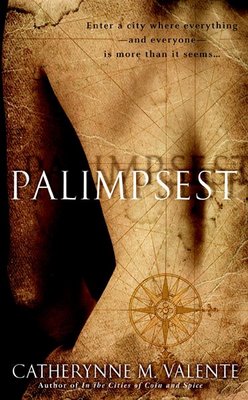Fantasy author Catherynne M. Valente told Tor.com that her new novel, Palimpsest, is an urban fantasy, but not in the way that term might imply; the eponymous Palimpsest is a sexually-transmitted city.
“It exists on the flesh of those who visit it, in a black mark that looks something like a streetmap,” Valente said in an interview. “When you sleep with someone bearing the mark, you can enter the city in dreams—but always limited to the part of Palimpsest that your lover carries on their skin. The novel follows four people: November, Ludovico, Oleg, and Sei, from all over the world, who become infected and then obsessed with Palimpsest, as they try to discover the nature of the place, and how to emigrate there, permanently.”
November is the most prominent of the four protagonists. “She is a young woman living in a suburb of San Francisco and working as a beekeeper,” Valente said. “She has extreme social anxiety and lives as a recluse until a single night in the city leaves her with a black mark on her face. Unable to hide what has happened to her, she begins an odyssey through the decadent clockpunk city of Palimpsest and through the real world, driving the others together. In Palimpsest, she becomes involved with Casimira the matriarch of the city and the instigator of a mysterious war in whose last battles November entangles herself.”
Writing Palimpsest was the first time Valente had written a novel set largely in the real world, rather than a secondary fantasy world. “That proved to be a terrific challenge—it’s easy to make a character interesting when they are a centaur, or a pirate,” Valente said. “Harder when it’s a lonely woman grieving for her dead father. These things are commonplace in our world, and it took a lot of time and thought to make November and her compatriots as compelling as their more colorful counterparts in Palimpsest. Palimpsest is a novel of internal worlds, and even in this life, our internal worlds are never drab.”
Palimpsest’s technology is best described as clockpunk. “[Its] political era might be called belle epoque,” Valente said. “Casimira is the foreman of a vast factory that turns out clockwork insects by the millions—they form her army and her spies. Throughout the city, half-human, half-animal war veterans roam, mute, cared for by public works projects. The city is surreal, decadent, sensual, a conglomeration of the warring dreams and passions of its inhabitants.”
Valente said that the novel was terribly personal. “It is simultaneously a story of a fantasy world and the burning desire to get there, and of lonely people trying to find connection on the edges of society,” she said. “Being a child of the internet and various subcultures, and also someone who has been often solitary in my life, I found myself writing an almost confessional novel about the places where many people can come together and create an entirely new space, a new country, sheerly out of their desire not to be alone.”










